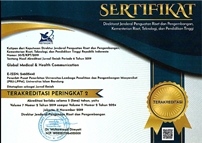Role of Chest CT Scan to Predict Malignancy on Mediastinal Mass
Abstract
Keywords
Full Text:
PDFReferences
Juanpere S, Cañete N, Ortuño P, Martínez S, Sanchez G, Bernado L. A diagnostic approach to the mediastinal masses. Insights Imaging. 2013;4(1):29–52.
Ghigna MR, Thomas de Montpreville V. Mediastinal tumours and pseudo-tumours: a comprehensive review with emphasis on multidisciplinary approach. Eur Respir Rev. 2021;30(162):200309.
Dixit R, Shah NS, Goyal M, Patil CB, Panjabi M, Gupta RC, et al. Diagnostic evaluation of mediastinal lesions: analysis of 144 cases. Lung India. 2017;34(4):341–8.
Rizvi S, Wehrle CJ, Law MA. Anatomy, thorax, mediastinum superior, and great vessels. In: StatPearls [Internet]. Treasure Island (FL): StatPearls Publishing; 2025.
Carter BW, Benveniste MF, Madan R, Godoy MC, de Groot PM, Truong MT, et al. ITMIG classification of mediastinal compartments and multidisciplinary approach to mediastinal masses. Radiographics. 2017;37(2):413–36.
Carter BW, Tomiyama N, Bhora FY, Rosado de Christenson ML, Nakajima J, Boiselle PM, et al. A modern definition of mediastinal compartments. J Thorac Oncol. 2014;9(9 Suppl 2):S97–101.
Aroor AR, Prakasha SR, Seshadri S, Teerthanath S, Raghuraj U. A study of clinical characteristics of mediastinal mass. J Clin Diagn Res. 2014;8(2):77–80.
Duwe BV, Sterman DH, Musani AI. Tumors of the mediastinum. Chest. 2005;128(4):2893–909.
Kulkarni S, Kulkarni A, Roy D, Thakur MH. Percutaneous computed tomography-guided core biopsy for the diagnosis of mediastinal masses. Ann Thorac Med. 2008;3(1):13–7.
Roshkovan L, Katz S. A multimodality approach to imaging the mediastinum and pleura: pearls and pitfalls. Appl Radiol. 2020;49(2):12–20.
Takahashi K, Al-Janabi NJ. Computed tomography and magnetic resonance imaging of mediastinal tumors. J Magn Reson Imaging. 2010;32(6):1325–39.
WHO Classification of Tumours Editorial Board. WHO classification of tumours: thoracic tumours. 5th Edition. Volume 5. Lyon: International Agency for Research on Cancer; 2021.
Pandey S, Jaipal U, Mannan N, Yadav R. Diagnostic accuracy of multidetector computed tomography scan in mediastinal masses assuming histopathological findings as gold standard. Pol J Radiol. 2018;83:234–42.
Amin Z. Demographic, clinic, radiologic, and histopathologic pattern of patient with mediastinal mass who died during treatment at Cipto Mangunkusumo Hospital Jakarta. Indones J Cancer. 2013;7(1):7–13.
Kaur H, Tiwari P, Dugg P, Ghuman J, Shivhare P, Mehmi RS. Computed tomographic evaluation of mediastinal masses/lesions with contrast enhancement and correlation with pathological diagnosis – a study of 120 cases. J Biomed Graph Comput. 2014;4(3):28–35.
Basudan AM, Althani M, Abudawood M, Farzan R, Alshuweishi Y, Alfhili MA. A comprehensive two-decade analysis of lymphoma incidence patterns in Saudi Arabia. J Clin Med. 2024;13(6):1652.
Pramesti MAN, Widyoningroem A, Sensusiati AD. Unusual spread of extranodal malignant lymphoma to the lung and nodal to the mediastinum; how do we know? Int J Res Publ. 2022;115(1):171–6.
Egeblad M, Nakasone ES, Werb Z. Tumors as organs: complex tissues that interface with the entire organism. Dev Cell. 2010;18(6):884–901.
Szolkowska M, Szczepulska-Wojcik E, Maksymiuk B, Burakowska B, Winiarski S, Gatarek J, et al. Primary mediastinal neoplasms: a report of 1,005 cases from a single institution. J Thorac Dis. 2019;11(6):2498–511.
Jeung MY, Gasser B, Gangi A, Bogorin A, Charneau D, Wihlm JM, et al. Imaging of cystic masses of the mediastinum. Radiographics. 2002;22(Spec No):S79–93.
Baba AI, Câtoi C. Tumor cell morphology. In: Comparative oncology [Internet]. Bucharest: The Publishing House of the Romanian Academy; 2007.
Martin TA, Ye L, Sanders AJ, Lane J, Jiang WG. Cancer invasion and metastasis: molecular and cellular perspective. In: Madame Curie bioscience database [Internet]. Austin: Landes Bioscience; 2013.
Al-Ostoot FH, Salah S, Khamees HA, Khanum SA. Tumor angiogenesis: current challenges and therapeutic opportunities. Cancer Treat Res Commun. 2021;28:100422.
DOI: https://doi.org/10.29313/gmhc.v13i1.14218
pISSN 2301-9123 | eISSN 2460-5441
Visitor since 19 October 2016:
Global Medical and Health Communication is licensed under a Creative Commons Attribution-NonCommercial-ShareAlike 4.0 International License.
- https://jurnal.narotama.ac.id/
- https://www.spb.gba.gov.ar/campus/
- https://revistas.unsaac.edu.pe/
- https://proceeding.unmuhjember.ac.id/
- https://ejournal.uki.ac.id/
- https://random.polindra.ac.id/
- https://jurnal.politeknik-kebumen.ac.id/
- https://scholar.ummetro.ac.id/
- https://ejournal.uika-bogor.ac.id/
- https://journals.telkomuniversity.ac.id/
- https://www.iejee.com/
- https://e-journal.iainptk.ac.id/
- https://journal.stitpemalang.ac.id/
- https://revistas.unimagdalena.edu.co/
- https://catalogue.cc-trieves.fr/
- https://revistas.tec.ac.cr/
- https://jurnal.poltekapp.ac.id/
- https://ojs.adzkia.ac.id/
- https://journal.umpalopo.ac.id/
- https://journal.unifa.ac.id/































.png)
_(1).png)
_(1).jpg)
